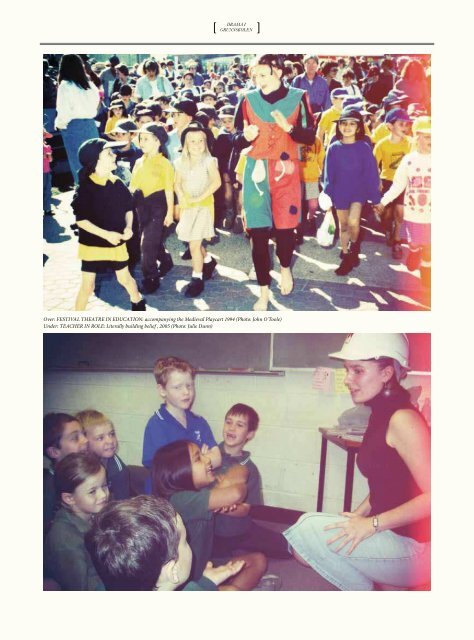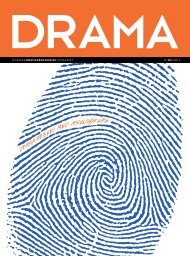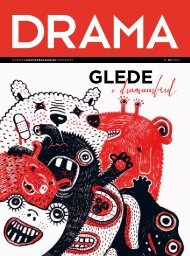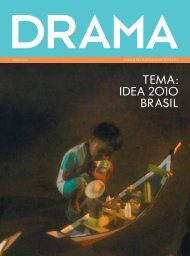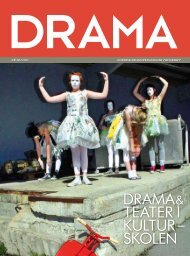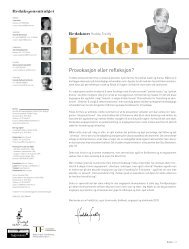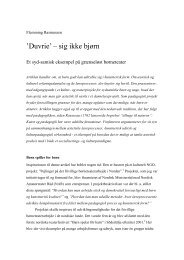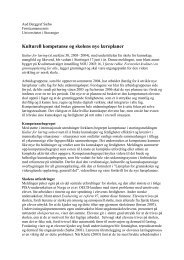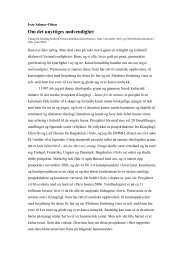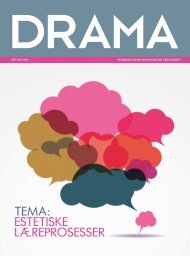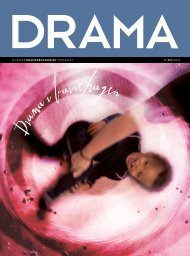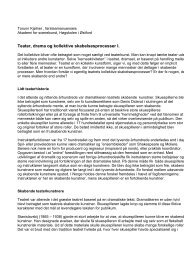tema: drama i grunnskolen - Landslaget drama i skolen
tema: drama i grunnskolen - Landslaget drama i skolen
tema: drama i grunnskolen - Landslaget drama i skolen
Create successful ePaper yourself
Turn your PDF publications into a flip-book with our unique Google optimized e-Paper software.
Drama iDrama i[ <strong>grunn<strong>skolen</strong></strong> ][ <strong>grunn<strong>skolen</strong></strong> ]Over: FESTIVAL THEATRE IN EDUCATION: accompanying the Medieval Playcart 1994 (Photo: John O'Toole)Under: TEACHER IN ROLE: Literally building belief , 2005 (Photo: Julie Dunn)also stirring in Victoria, which had the first<strong>drama</strong> teachers’ association, and was training<strong>drama</strong> teachers before there were anyofficial jobs for them; and South Australia,where the first formal <strong>drama</strong> state syllabus,Images of Life (1981), was created. Here too,six years earlier, the first meeting was held ofNADIE, the National Association for Dramain Education (now Drama Australia), whichhas unquestionably been the strongest advocateand most unifying influence for <strong>drama</strong>ever since. The strong unity and sense ofcommunity NADIE generated, which hasbeen a characteristic of Australian <strong>drama</strong>education, had the vital effect of preventingwhat we called ‘the British disease’ ofthe 1990s, with its rancorous splits between‘theatre and <strong>drama</strong>’, between ‘process andproduct’ and between ‘art and pedagogy’.To us, all these apparent opposites were justpoints on the continuum of the art formwe all loved and shared. Brad Haseman’sand my quite influential book Dramawise,published in Scandinavia as Drama og teater:en pædagogisk metode (1995) was partlywritten to scotch that divisive nonsense. Bythe 1980s Australians were writing our own<strong>drama</strong> textbooks, and starting to export expertiseas well as import it – back to the UKand Europe, and in recent years, particularlyto South East Asia. Most teacher educationcolleges had <strong>drama</strong> departments from the1970s and were beginning to train (mainlysecondary) <strong>drama</strong> teachers, and give <strong>drama</strong>pedagogy to primary teachers.I have seen one thing change, massively, inthe thirty five years I have been practisingteacher education here, and that is the attitudeto <strong>drama</strong> among teachers and schools(and also among the general public): fromthinking <strong>drama</strong> was a waste of time or atbest a marginal extra, to recognising itspotential as a force for learning and for developingself-confidence, and as an art-form.This has been as true in primary as secondaryeducation, but there has been a deep andso far insoluble problem. The tiny – and evershrinking – amount of time spent in pre-serviceteacher education on <strong>drama</strong> either as artform or as a liberating aesthetic pedagogyhas been just enough (I have seen it year inand year out) to excite students with the visionand the possibilities, but not enough togive them either <strong>drama</strong> skills or confidenceto sustain <strong>drama</strong> teaching in schools, wherethere is rarely much strong support or encouragement,and neither incentive nor timeavailable for nervous first-year graduates tolearn and adapt to this exciting pedagogy sofar from their own previous experience.Drama in the National Curriculum. Thegolden moment which may have arrivedis Australia’s first National Curriculum,which includes the Arts (ACARA 2011) andhas mandated <strong>drama</strong> throughout primaryschooling, in parity with dance, media arts,music and visual arts (the last two have beentraditionally much longer established). From2013 teachers will have to teach <strong>drama</strong>, andour information is that a surprising numberare looking forward to the permission andeven to the challenges.The spine of the new primary curriculumwill be learning to recognise, understandand manage the elements of <strong>drama</strong>, bothin <strong>drama</strong>tic process and theatrical product.The arts, play and <strong>drama</strong> are central to thenew Early Years Learning Framework (2010),and in the early years (Pre-school 0 Year 3)many teachers are already accustomed touse <strong>drama</strong>tic play with their charges (withthe possibilities for sustained <strong>drama</strong>tic playrather more than we hear are apparently available,sadly, in Norway). This will form thecentre of their <strong>drama</strong> work, along with roleplayand process <strong>drama</strong>, experimenting withprojected play, puppets and <strong>drama</strong>tic media,and informal, unscripted in-house performance.In the middle years, more siophisticatedprocess <strong>drama</strong> will be encouraged,along with the beginnings of playbuilding,and performance to familiar but broadeningaudiences. By the upper primary years, thestudents will use all the <strong>drama</strong>tic elements incomplex process <strong>drama</strong> work and playbuilding;they will engage with significant scriptedtext as performers and audience, and justbegin to explore the world of theatrical playwriting,production and direction.This is an ambitious curriculum, and formany years teachers will struggle to find sufficientsupport, in order to develop sufficientskills themselves. Drama will be taught patchilyin places, badly in some, and ignored intoo many… but ignoring it means non-compliance,and after all, didn’t we of the last twogenerations become <strong>drama</strong> teachers ourselvesthis way, by trial and error, and withthe enthusiastic tolerance and generosity ofour students? That’s my hope for the future.references:ACARA (2011). Shape Paper: The Arts. Sydney:Australian Curriculum, Assessment andReporting Authority.DEEWR (Department of Education, Employmentand Workplace Relations). (2010). EarlyYears Learning Framework. Canberra: Officeof Early Childhood Education and ChildcareO’Toole, J. & Haseman, B. (1995). Drama ogteaterHYPERLINK "http://ask.bibsys.no/ask/action/show?pid=96001165x&kid=biblio": enpædagogisk metode. (Dramawise). Copenhagen:Drama books.Parsons, B., Scheffner, M., Little, G. & Felton,H. (1984). Drama, Language and Learning:NADIE Paper No 1. Hobart: National Associationfor Drama in Education.Queensland Studies Authority (2002). TheArts Years 1-10: Syllabus and sourcebook guidelines.http://www.qsa.qld.edu.au/673.htmlaccessed 12 September 2011.Education Dept. of South Australia (1981).Images of Life. Adelaide: EDSA, PublicationsBranch.author’s biography:John O’Toole has been teaching and workingin educational <strong>drama</strong> and theatre for nearlyforty years, mainly in Australia, althoughhe has taught <strong>drama</strong> to all ages on all continents.He has written or co-written manystandard books on the subject, both researchworks like Theatre in Education (1977)and The Process of Drama (1992), and textbooks,of which the most well-known areDramawise, with Brad Haseman, translatedinto Danish as Drama og teater : en pædagogiskmetode (1995) and the primary teachers’book Pretending to learn, with Julie Dunn,also translated into Danish as Dramaforløbi <strong>skolen</strong> (2005). John is the Lead Writer forthe Arts, and for Drama, in the forthcomingAustralian Curriculum, and was formerlyProfessor of Drama and Applied Theatre atGriffith University, Brisbane (1992–2005)and Foundation Chair of Arts Education atthe University of Melbourne (2005–2010).16 dr a m a n r .o3 _ 2 o11dr a m a n r .o3 _ 2 o11 17


